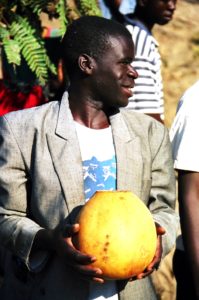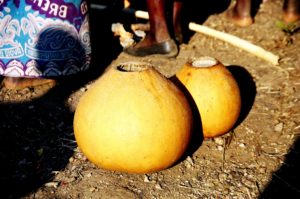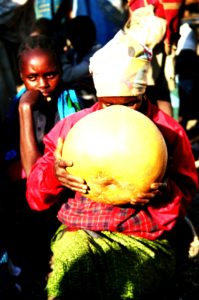by
Mwizenge S. Tembo, Ph. D.
Professor of Sociology
Introduction.
You can use plastic, metal, or a porcelain cup to drink all types of drinks and fluids including water when you are in the village. You will enjoy your drink. But nothing can compare to the distinctive unique scent, aroma, and soul you experience when you drink from a chipindi. This is sometimes called a calabash or gourd. The very essence of what it means to be kukaya is to drink from a chipindi or nkhombo. There are at least 4 traditional brews that are best consumed using either chipindi or nkhombo; Mthibi, Zinduku, Thobwa, Chinya, Mtaba, and Moba (beer). All of these traditional brews either use vingoma (maize or corn) or Lupoko (finger millet).
Vingoma (maize or corn) and Lupoko (finger millet).
The beginning of the making of these traditional brews starts with proper preparation of vingoma or Lupoko. Depending how much

of the traditional brew is to be made, certain amounts of maize or lupoko are soaked in water for three days. Exactly what is done with the maize is done with the lupoko. We will just mention the maize. The water is then drained and thrown away. The moist maize is then spread in a chihengo or a wide flat container. The maize is covered with a wide piece of paper or cloth and placed away in a secluded location may be somewhere in the kitchen or basement. After 3 days the maize will germinate. You then spread the germinated maize on a flat mphasa (mat) or chihengo and dry it in the sun. After the germinated vingoma (maize) or lupoko (finger millet) is dry, grind it into flour using an electric grinder, a pestle and mortar, and if you are in the village you can use a diesel driven hammer mill. This maize or lupoko flower is now called chilungo.
The Making of the Traditional Brews
Grind a large amount of maize into flour called mgaiwa. Get a large pot or clay pot and fill two thirds of it with plain water. Place the container on a good fire or on high on a cooking stove. When the water is lukewarm, slowly sprinkl large handfuls of the mgaiwa maize meal while stirring. Once the contents begin boiling and splattering, cover the pot. Lower the heat. Let this boil for at least an hour while occasionally stirring it. If it thickens, add more water to thin it.
Take the hot pot off the fire and place it on the side. Slowly pour in the chilungo and stir it thoroughly. If the hot contents are two gallons you can pour and stir in 2 to 3 cups of maize chilungo. If you are brewing Mthibi, you pour in lupoko chilungo. Cover the pot and put it away either in the corner of the kitchen or away in the basement. Traditionally the boiling is done in large clay pots.
Thobwa, Mthibi, Zinduku, Chinya, Mtaba, and Moba (beer).
What happens to the large pot with the cooling mixture is that if it left to ferment for exactly one week, it turns into moba or beer. This is why this traditionally brewed beer is called seven days in the villages or moba wa masese. If the following morning you and your family want to

drink thobwa, you can get the cooled down maize chilungo mixture and boil it while stirring it. If it is thick, pour some water to thin it. Bring it to a boil. You can drink this with your family as part of breakfast or a snack. You do not need to add sugar as the thobwa should be lightly sweet already.

Mthibi
The Mthibi sweet drink can only be made from lupoko chilungo. You wait up to three days before it ferments and ripens to the Mthibi sweet drink. The well brewed Mthibi should be sweet, thin or watery but filling. The lupoko residue should be at the bottom of the drink. You can use a cup although he best would be to use chipindi or nkhombo (gourd cup)
Mtaba and Chinya
Mtaba is what the maize chilungo mixture turns into at about the second day. It is bubbly but with a nthya nthya taste close to what a yogurt taste. The taste does not have an equivalent in
English. At this stage children and other non-alcohol drinkers can enjoy the tasty brew. Chinya is what the drink turn into on the sixth day on the verge of becoming fully moba (beer). Chinya can still be enjoyed by all non-alcoholic drinkers. All of these drinks have a special flavor and aroma when using the chipindi to drink it. On the seventh day, the whole mixture fully turns into beer. Beyond the seventh day, the maize chilungo turns into stronger beer.
